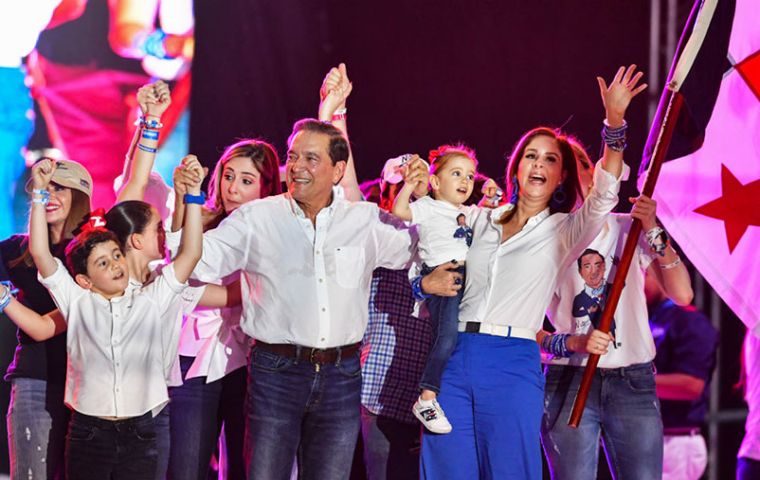MercoPress. South Atlantic News Agency
OAS congratulates Panama on Sunday's vote which proclaimed Laurentino Cortizo as president elect
 On Sunday, with 95.01% of the votes processed, the Electoral Tribunal called candidate Laurentino Cortizo to inform him that he was the virtual president-elect
On Sunday, with 95.01% of the votes processed, the Electoral Tribunal called candidate Laurentino Cortizo to inform him that he was the virtual president-elect The Electoral Observation Mission of the Organization of American States (OAS) for the General Elections in Panama congratulates the people and the electoral authorities of Panama on a successful election day, which took place in an organized manner, in an atmosphere of civility and with high participation.
At the end of voting day, Laurentino Cortizo was announced as winner and the next Panamanian president by the country's Electoral Tribunal.
The Mission, headed by former president of Colombia Andrés Pastrana, included 62 observers from 18 countries and was deployed throughout the country. On Sunday, the Mission's observers and technicians visited 1,067 voting stations in 303 centers, from their installation to the counting and transmission of results. Voting stations opened in a timely manner and had the necessary materials so that the citizens could vote.
The Mission observed that the registration was organized by ID number, and not in alphabetical order, a procedure that delayed the process locating the voting stations and identification of voters, and contributed to the formation of long lines in numerous centers. However, citizens maintained a cheerful and participatory spirit, and waited patiently for their turn. Most voting stations were installed with all its members present. Throughout the day, those members demonstrated their commitment and responsibility with Panamanian democracy.
The Mission noted a high presence of representatives of political parties and free application candidates throughout the day. The presence of delegates from electoral groups, promoters and informants facilitated the process to take place in a organized manner.
In addition, the Mission noted that polling stations were guarded by security forces, fire department, the Red Cross and personnel of the civil protection system, a fact that ensured that any dispute and inconvenience could be Solved effectively. Citizens also participated actively through national observation organizations, which had a notable presence in the polling stations.
One aspect that drew attention to the OAS observers was the lack of a protocol established for the companions in assisted voting. In different areas of the country, the Mission observed cases in which the same person accompanied several different citizens to vote and were thus reprimanded by electoral delegates. In this context, it is noteworthy that the Electoral Code simply establishes that “the notoriously blind and physically unable to act without help may be accompanied by people they trust”. This provision allows a certain degree of discretion over who can act as a companion and should be reviewed.
The closing of voting stations includes a series of very specific procedures that delay start of the count. Within half an hour of closing the vote, the Electoral Tribunal began to release unofficial results of the presidential election through its website, as well as the media throughout the country. In this way, citizens could follow the advance of the recount in a direct and efficient manner.
At 23:40 on Sunday, with 95.01% of the votes processed and 92.36% of the minutes scrutinized, the Electoral Tribunal called candidate Laurentino Cortizo to inform him that he was the virtual president-elect, with a difference of approximately 37,000 votes over the next candidate. Both the Tribunal and the winning candidate made reference to the right that exists in Panama to contest results by a contestant in case of nonconformities.
Later, Cortizo received a call from President Juan Carlos Varela. The trends observed and data collected by the OAS Mission are consistent with those reported by the Electoral Tribunal. .
The Mission will remain in Panama until the end of the scrutiny and at a later date it will make public a more extensive technical report including its main findings and recommendations on key aspects of the electoral process: organization, technology and electoral justice, political financing, voting abroad, political participation in women and indigenous peoples, as well as media and social networks.
Ultimately, the Mission will present its final report end on the election to the OAS Permanent Council at OAS headquarters in Washington, DC.




Top Comments
Disclaimer & comment rulesCommenting for this story is now closed.
If you have a Facebook account, become a fan and comment on our Facebook Page!